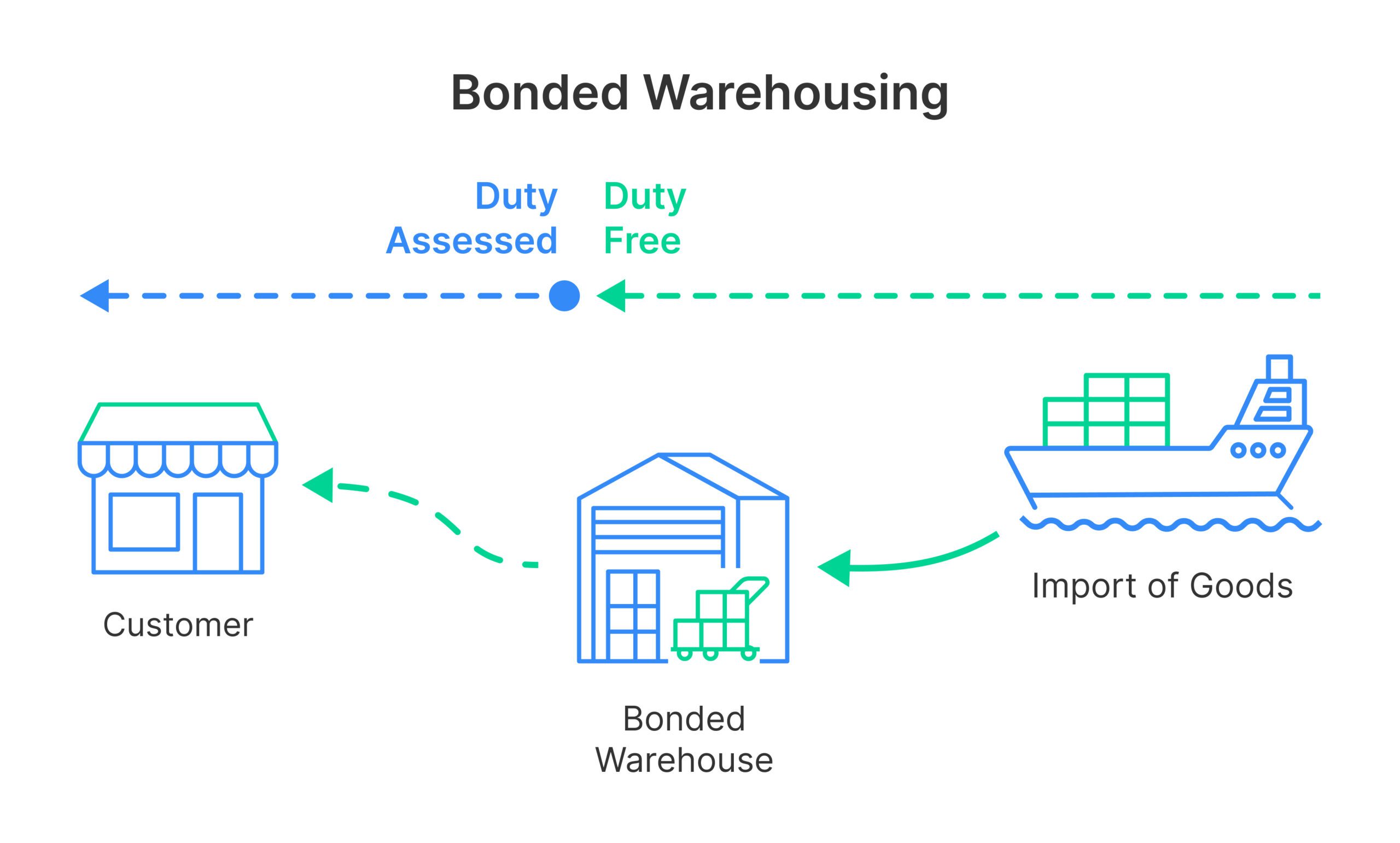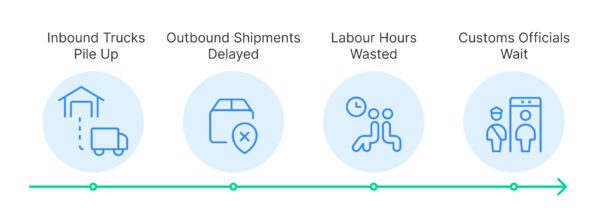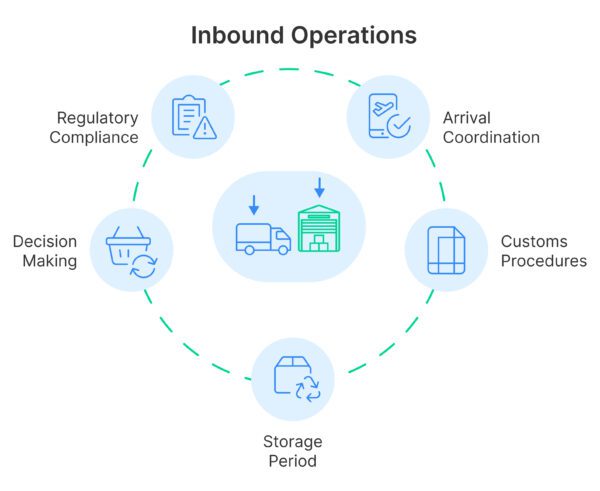
📚 Table of Contents
- Introduction: Why Visibility is Critical in Bonded Warehouses
- What is a Bonded Warehouse?
- Types of Bonded Warehouses
- Bonded vs Non-Bonded Warehouse: Key Differences
- What’s the Biggest Operational Challenge in Bonded Warehouses?
- How Dock Scheduling Helps You Manage Inbound & Outbound Efficiently
- Summary Table: Inbound vs Outbound Logistics
- Inbound Operations: Importation and Storage
- Arrival Coordination
- Customs Procedures
- Duty-Deferment Storage Period
- Outbound Operations: Release, Export, or Distribution
- Withdrawal Scheduling
- Domestic Distribution
- Proven Impact: What Dock Scheduling Delivers
- Final Word
We all know the feeling of a business owner eagerly tracking their goods and then leaving them at a bonded warehouse until they pay their customs duty charges. As a bonded warehouse manager, it is your duty to safely store and manage these goods under your complete visibility.
The biggest roadblock is when a bonded warehouse, inbound shipments of goods, can’t be unloaded until customs paperwork is checked and approved. For outbound, nothing moves until duties are paid or re-export permission is given. That means timing becomes tricky and often unpredictable.
Now add in people like customs brokers, importers, warehouse teams, and carriers, all trying to stay in sync without shared updates. The simple solution to this is indeed being hyper-focused on the inbound & outbound processes and operational improvement. Especially, the yard and dock area, which is a black hole crying out for visibility.
If you are one of those folks, already familiar with what a bonded warehouse is, you can skip to the subsequent section 1.3, to save your time, because that’s where we are going to discuss strategies that make your process up to 3x quicker and have a whole lot of visibility into your bonded facility.
What is a Bonded Warehouse?
A bonded warehouse is a storage facility where imported goods can be kept without paying customs duties or taxes upfront. These goods are held under customs supervision until they’re either for local use, re-exported, or further processed.
If you have ever been to an international airport and seen duty-free products, those products also haven’t yet entered the local economy and aren’t subject to local taxes. Businesses use bonded warehouses the same way: to store imported goods under customs control, deferring duties until those goods are released or re-exported.
Bonded Warehouses don’t store every internationally shipped product, though some restricted items, for instance, tobacco, artwork, alcohol, and some more, are kept there until the real owner claims it and clears all customs.
Types of Bonded Warehouse:
There are different types of bonded warehouses, but the two most important are a
- Private bonded warehouse, which is operated by a private entity, such as a warehouse proprietor or a 3PL.
- A public bonded warehouse operated through the government.
If you want more information on other types of bonded warehouses, please read here.
What is the Difference Between Bonded and Non-Bonded Warehouse?
The main difference between bonded and non-bonded warehouses comes down to when you’re required to pay duties and taxes.
With a non-bonded warehouse, you have to arrange a customs inspection and pay all applicable taxes as soon as your goods arrive. On the other hand, a bonded warehouse lets you delay both the inspection and payment until you’re ready to take your goods out of storage.
What is the Biggest Blocker That Hurts Bonded Warehouses’ Bottom Line?
When the truck reaches the bonded facility gate, unloading cannot begin unless customs has officially approved the shipment to be placed under bond. First, the basic inspection is handled at the bank. After that, the products are shifted to a bonded warehouse, then customs clears the shipment, which typically takes 3–5 days. While the customs process itself is standard, what really hurts operations is this: Inbound trucks, outbound shipments, and warehouse labour are all running on disconnected timelines.
- Inbound trucks pile up at the gate, waiting for documents.
- Outbound shipments are delayed because space is blocked by uncleared goods.
- Labour hours are wasted, waiting for approvals or free docks.
- Customs officials often have to wait, too, because shipments weren’t properly scheduled.
These deferred times cause congestion and also cause detention and demurrage charges, which is paid by bonded warehouses for waiting beyond the allowed free time, and can range from $25 to $100, depending on your location.

How to Manage Inbound & Outbound Loads in a Customs Bonded Warehouse via Scheduling?
Effective scheduling warrants quicker customs clearance, better truck turnaround, and enhanced warehouse throughput, directly safeguarding your bottom line. But first, let’s revise the key attributes and differences between inbound and outbound in a bonded warehouse.
Quick Inbound and Outbound Summary Table:
| Attribute | Inbound Logistics | Outbound Logistics |
|---|---|---|
| Direction | Inward | Outward |
| Focus | Supply | Demand |
| Function | Receiving | Delivery |
| Parties | Suppliers, vendors, distributors | Wholesalers, retailers, end customers |
| Processes | Sourcing, procurement, handling, putaway (bonded if under customs control) | Fulfillment, packing, shipping (after clearance if bonded) |
| Movement | Goods arriving from suppliers (bonded or non-bonded) | Goods dispatched to customers (cleared if bonded) |
| Objective | Secure materials for production (duty deferred if bonded) | Meet demand and ship legally (customs-compliant if bonded) |
Let’s start with inbound operations and it’s process flow
Inbound Operations: Importation and Storage
Inbound operations involve everything from the time goods arrive in the country to when they are stored under customs control inside a bonded warehouse. Let’s start with the inbound process.
Arrival Coordination
Goods arrive via international freight (often sea or air). When they arrive, the importer or freight forwarder provides an ETA to the bonded warehouse. The bonded warehouse operator and customs authorities are notified in advance. At this stage, getting the dock ready for unloading is a critical step. The best warehouses pre-plan loads and use a central portal where brokers, carriers, and warehouse teams get real-time updates and clear instructions, no back-and-forth needed.
So they can pre-book a dock slot for unloading based on the estimated vessel or flight arrival time.
- ✓ To align warehouse capacity and customs availability with shipment arrival.
- ✓ To prevent congestion or unplanned trailer/truck buildup.
Customs Procedures
Upon entry into the bonded warehouse, goods are placed under customs supervision.
The warehouse is bonded, meaning the operator and importer assume joint liability under a customs bond. Suppose there are no customs duties or taxes that have been paid. Duty payment is deferred until goods leave the warehouse, and this is allowed for up to 5 years.
- At this stage, the importer must submit:
- Import declaration
- Bill of lading
- Commercial invoice
- Other regulatory documents
When submitting this paperwork, digitizing these forms/documents can instantly cut your workload in half.
This is where dock scheduling software plays a key role in maintaining full compliance. A platform like Arrivy allows you to upload digital versions of key documents, like the bill of lading, custom tax report, invoices, store them securely in the cloud, and link them directly to customer profiles or scheduled tasks.
But not only this, these files can be annotated, tracked, and reviewed by every stakeholder involved in the supply chain. With role-based access controls, only assigned users can view, share, or edit documents, ensuring that sensitive information is protected and only visible to those who need it.
Choosing a solution like Arrivy means everyone stays in sync, from customs brokers to warehouse staff, making your logistics process faster, more transparent, and fully compliant until the outbound starts.
- ✓ To ensure that goods are accounted for, tracked, and held legally within the bonded framework.
Storage Period
Goods are stored securely in designated bonded zones. The importer can delay payment of duties while deciding:
- Whether to re-export the goods
- Whether to distribute them domestically
Even during the duty-deferred storage period, precise coordination is critical. Dock scheduling software helps you plan, monitor, and control all bonded movements with full traceability.
- Assign bonded tasks in advance, including customs inspections, re-export prep, or local distribution, reducing bottlenecks and manual follow-ups.
- Attach and centralize regulatory documents like entry forms, release authorisations, and storage compliance reports directly to each task or shipment.
- Automated alerts and scheduling logs help you track when goods are due for re-export or domestic clearance, minimising the risk of breaching the 5-year storage limit or compliance deadlines, as well. With Dock Scheduling Software, you can also prepare all stakeholders and send reminders to everyone.

In a bonded environment where every movement is logged and regulated, dock scheduling software like Arrivy ensures you stay compliant, efficient, and always ready for the next step, whether it’s export, delivery, or customs release. See Arrivy in Action
- ✓ To provide tax and cash flow advantages to the importer.
- ✓ To give businesses flexibility in responding to market demand or regulatory changes.
Outbound Operations: Release, Export, or Distribution
Outbound begins after customs clearance or payment of duties. This is the point when goods are legally released from the bonded warehouse and can either be delivered to the domestic market or exported. No goods can move out until this compliance step is completed.
Digital tools keep your team in the loop as soon as customs paperwork is finalized, allowing them to act fast and schedule the next steps without waiting around.
Withdrawal Scheduling
The importer or customs broker informs the bonded warehouse that goods are ready for withdrawal. A formal release request is submitted to customs. Once approved, the goods are cleared for pickup. This whole process can be created in a workflow.
- Assigns a specific dock slot for the carrier based on customs release timing, avoiding clashes and bottlenecks.
- Automatically syncs pickup schedules with customs clearance status, so no truck arrives before the shipment is legally cleared.
- Enables real-time coordination between customs, warehouse, and transport teams through shared portal access and notifications.
- Tracks document readiness (e.g., release order, clearance receipt), ties these documents with statuses, ensuring everything is uploaded and available before withdrawal.
- ✓ To provide tax and cash flow advantages to the importer.
- ✓ To give businesses flexibility in responding to market demand or regulatory changes.
Domestic Distribution
- Cleared goods are handed over to a domestic transporter for final-mile delivery.
- Scheduling software can coordinate:
- Allocating precise pickup windows to avoid clashes and ensure readiness in the dock area.
- Enabling route optimization based on real-time traffic, delivery zones, and customer availability, this can also be done by connecting IOT or TMS.
- Sending automated carrier notifications for smoother coordination between the warehouse and the transporter.
- ✓ To guarantee an easy transition from bonded storage to active distribution channels.
- ✓ To minimise last-minute congestion at the warehouse by pre-planning carrier movement.
- ✓ To improve overall delivery timelines & customer satisfaction through better visibility and control.
Proven Impact: What Dock Scheduling Delivers
The benefits of automated dock scheduling aren’t just theoretical; real-world data shows measurable savings in time, cost, and efficiency.
Results:
✓ Through minimizing manual scheduling work and alignment, automated scheduling can reduce labor costs by 15%. Optimization lowers truck wait times, yielding 20% smaller overtime charges from fewer holdups.
✓ Inbound Logistics indicates that an integrated logistics and contract management strategy usually allows firms to reduce demurrage and detention charges by 25–50%, with some saving $260,000 each year at one port.
✓ TrueCommerce emphasizes that dock scheduling software offers tools to visualize, automate, and enable suppliers, removing delays and avoidable detention expenses.
Final Word:
While there are numerous benefits and many small actions your team can take to create significant impacts through Dock Scheduling on these changes inside your bonded warehouse, you don’t need to enact everything at once. Indeed, Arrivy experts advise against it. By adopting a crawl, walk, run, and FLY method, we want you to address these together to improve the entire supply chain. We’re prepared to help you identify the right next step. Discover where your biggest bottlenecks exist, and start reducing expenses as soon as possible with Arrivy Today.
